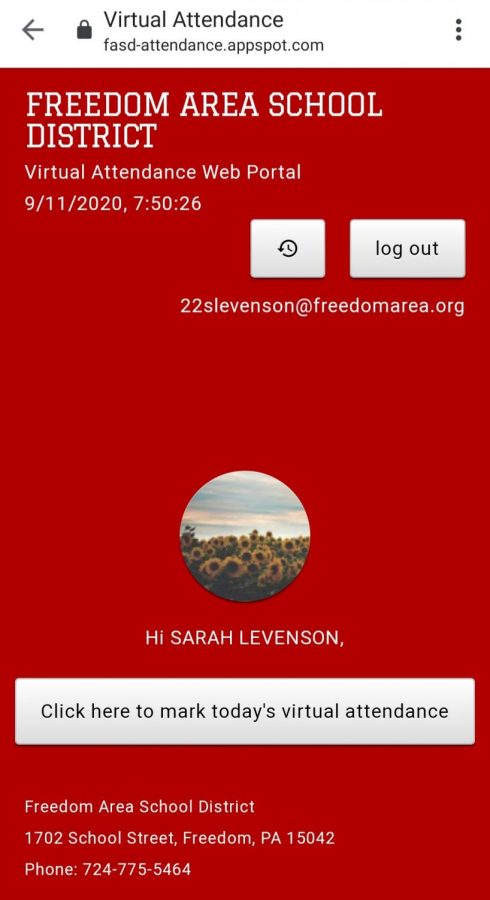Virtual learning continues to evolve
The high school’s new virtual attendance web portal for the 2020-2021 school year that records attendance with a simple click of the gray button in the middle of the screen each day.
Plans can be improved and refined by taking more time to think about them. When school shut down on March 13 due to the COVID-19 pandemic, teachers and staff had no reason to develop a plan for online school, as they were under the impression that we would be gone for a short break. Instead, students were thrown into online school two weeks later and are still continuing virtual learning for the start of the 2020-2021 school year.
While the last school year ended with some bumps in the road, Freedom started online school this fall with a well-thought-out plan and a few changes to the process.
The most noticeable change in the high school’s online school system from the spring compared to now is the basic daily schedule. Last spring, teachers were required to be online in a google meet from 10 a.m. to 2 p.m. each week day in case a student had a question about an assignment. Now, teachers hold live classes from 8 a.m. until 2:30 p.m. on Google Meet, so that students can have a day that more closely resembles a typical in-person school day. Students now take notes as their teachers talk, raise their hands to answer questions and remain connected to the Google Meets while they complete assignments or take tests. For some students, their virtual learning experience has improved by having a more concrete routine, rather than being left on their own to work.
“The teachers are more organized and prepared this time, unlike in the spring where they just threw work at us,” freshman Morgan Shaffer said.
Even though this year’s freshmen had to start high school virtually, they were still able to survive the transition all the same. They noted that the block schedule is much better for online school compared to the traditional period schedule at the middle school.
“The current schedule is so much better now with the four blocks rather than doing nine periods online, because for the most part, it helps me stay on task,” Shaffer said.
Another difference between this year’s virtual plan and last year’s is due dates. Last year, many teachers pretty much eliminated due dates and accepted online work from March in May. However, since teachers are more prepared this time around and the students know what to expect, Freedom is following its typical late-work policy where late work is accepted five days after the due date for 50 percent of the credit.
Freedom also made an important district-wide change for online school this fall. Every student in kindergarten through twelfth grade now has their own Chromebook, which allows all students to complete their work online without needing to get paper worksheets from the school.
The last big difference between online school this fall, compared to the spring, is the attendance process. Previously, students had to complete a daily check-in form for their PLT teachers. Now, they receive a daily email and simply have to click a link to a virtual attendance web portal, where students can then click a gray button that marks their attendance for the day. Students are also now required to submit the check-in form from the spring, except now it is only needed once a week to count as PLT attendance.
Even with these new changes to Freedom’s virtual learning process, there are still high schoolers who prefer how online school was handled in the spring over now, and those who dislike both and want to learn in-person, in an ideal world. But life is not always ideal, and we can only try our best to improve less than ideal situations, as Freedom did with online learning this time around.



